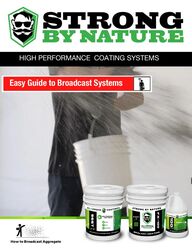
Return to flip book view
Easy Guide to Broadcast SystemsHIGH PERFORMANCE COATING SYSTEMSHow to Broadcast Aggregate
Aggregate floors need to be installed over a completely smooth, levelsurface that is free of cracks, voids, or hills. If installing over a concreteslab, fill any cracks or chips with an epoxy mortar mix. If your floor isuneven, with hills or valleys, consider pouring a self-leveling compoundover it before you begin. Self-leveling compounds seek out the valleys ina floor and level them automatically. When it's dry, you have a solid, flatfloor suitable for covering with aggregate flooring.The aggregate floor is then finished with a top coat. This topcoat iswhat gives the floor its durability. It is mixed and rolled onto the floorthe same way the base coat was: in two parts combined just beforeapplying. You may choose to put one or two coats of sealer on theaggregate. One coat will produce a floor with more texture, which givesa non-skid grip to the floor. Two coats produce a smoother (butsubstantially less anti-slip) and glossier floor where no individual chipscan be felt. If you choose to use two coats, wait a full 24 hours betweenapplications to ensure thorough drying time.To add aggregate for slip resistance, the prepared substrate receives abase coat of FX-100. While the FX-100 is wet, the aggregate is broadcastto full saturation (covered completely) and allowed to bond overnight.Excess aggregate is then cleaned away.Solid Color TintClear CoatPreparationAdding a TopCoatEasy Guide to Broadcast SystemsFLEXROCKFLEXROCKBefore AfterFLEXROCK FX-100 Broadcast Aggregate
Pour and Back Roll2While the FX-100 is wet, the aggregate is broadcast(throw in the air on to wet floor) evenly distribute. Donot worry about putting on too much. This will besealed in with the topcoat application. The more youput on the better slip resistance you get.30 minutesworking time30 minutesworking time24 hours later Apply TopCoat Broadcast Aggregate1Apply FX-100 as a base coat. Pourand roll evenly, be sure to fill in anycracks or imperfections in the floorand have a smooth you even surface.34Easy Guide to Broadcast SystemsAdd Aggregate For Slip ResitancesBe Prepared to CoatAfter 24 hours and the base coat hasdried. Remove any loose aggregateby sweeping or vacuuming. Remove Excess AggregateYou may choose to put one or two coats of sealer on theaggregate. One coat will produce a floor with more texture,which gives a nonskid grip to the floor. Two coats produces asmoother, with less slip resistance glossier floor where noindividual chips can be felt.grit aggregate is recommended for outdoor areas*Even with installing an aggregate, always use caution when floors are wet.#20-36
Choosing the correct aggregate can be based on several different factors from the type of coating that is being used toenvironmental conditions and desired finish and amount of slip resistance required. Silica sand is semi-angular in shape and is suitable in a variety of applications. This sand can be used in thin mil orhigh build pigmented coatings depending on the mesh size. They are broadcasted into the coating, broadcasttechnique will vary depending upon slip resistance desired.Most common silica sands used:20-40 mesh (“0” sand)- creates a rough surface, for use in high-build pigmented coatings40-60 mesh (“00” sand)- creates a textured surface, for use in high-build pigmented coatings40-100 mesh (Ottawa)- creates a mild texture, for use in high-build and thin mil pigmented coatings.Aluminum Oxide Powders: Aluminum Oxides are angular, sharp aggregates. They are extremely hard and will stand up to heavy and abusivetraffic. This aggregate is broadcasted into the coating.Most common colors and mesh sizes:White Aluminum (46 grit)- for use in both thin mil and high build, clear and pigmented coatingsBrown Aluminum (24, 36, 60 grits)- for use in high build pigmented coatingsSilica Sand:Easy Guide to Broadcast SystemsFlexRockCoatings.com | 800.808.0414 | info@flexrockcoatings.com